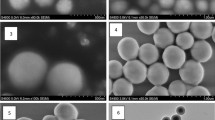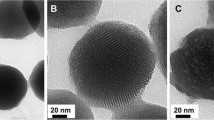Abstract
ZnS:Mn2+ quantum dots (QDs) Fe3O4 QDs/SiO2/P(NIPAAm-co-AAm) core-shell-shell nanocomposites have been successfully fabricated by free radical polymerization method. The average diameter and LCST of ZnS:Mn2+ QDs Fe3O4 QDs/SiO2/P(NIPAAm-co-AAm) (NIPAAm:AAm=90:10) nanocomposites was about 200 nm and 41.1°. It possessed a strong yellow-orange emission peak centered at 589 nm from the Mn2+ 4T1-6A1 transition and the desired superparamagnetic property at room temperature. The DOX encapsulation efficiency and loading capacity was 88% and 15.3 wt%, respectively. The nanocomposites showed the faster drug release behavior at 43 °C than that at 25 °C in vitro release experiment, and exhibited no significant cytotoxicity against the HeLa, HepG2 and HEK293 cell lines. Red fluorescence was observed in the cytoplasm of HeLa cells, confirming its application for biolabeling. Effective tumor inhibition was realized in vivo without the induction of toxicity in mice.

ZnS:Mn2+ (QDs) Fe3O4 QDs/SiO2/P(NIPAAm-co-AAm) nanocomposites showed the red fluorescence in the cytoplasm of HeLa cells, faster drug release behavior at 43 °C than that at 25 °C in vitro, and effective tumor inhibition in vivo, confirming its application for drug delivery.








Similar content being viewed by others
References
Mura S, Nicolas J, Couvreur P. Stimuli-responsive nanocarriers for drug delivery. Nat Mater. 2013;12:991
Sanchez C, Belleville P, Popall M, Nicole L. Applications of advanced hybrid organic-inorganic nanomaterials: from laboratory to market. Chem Soc Rev. 2011;40:696
Li M, Liu X, Xu Z, Yeung KWK, Wu S. Dopamine modified organic-inorganic hybrid coating for antimicrobial and osteogenesis. ACS Appl Mater Interfaces. 2016;8:33972
Timin AS, Gao H, Voronin DV, Gorin DA, Sukhorukov GB. Inorganic/organic multilayer capsule composition for improved functionality and external triggering. Adv Mater Interfaces. 2017;4:1600338
Rezaei SJT, Nabid MR, Niknejad H, Entezami AA. Multifunctional and thermoresponsive unimolecular micelles for tumor-targeted delivery and sitespecificallyrelease of anticancer drugs. Polym (Guildf). 2012;53:3485
Yang X, Luo Y, Xu F, Chen Y. Thermosensitive mPEG-b-PA-g-PNIPAM comb block copolymer micelles: Effect of hydrophilic chain length and camptothecin release behavior. Pharm Res. 2014;31:291
Karg M, Hellweg T. New “smart” poly (NIPAM) microgels and nanoparticle microgel hybrids: properties and advances in characterisation. Curr Opin Colloid Interface. 2009;14:438
Fan T, Li M, Wu X, Li M, Wu Y. Preparation of thermoresponsive and pH-sensitivity polymer magnetic hydrogel nanospheres as anticancer drug carriers. Colloid Surf B. 2011;88:593
Liu G, Hu D, Chen M, Wang C, Wu L. Multifunctional PNIPAM/Fe3O4-ZnS hybrid hollow spheres: Synthesis, characterization, and properties. J Colloid Interf Sci. 2013;397:73
Chen Y, Chen HR, Shi JL. In vivo bio‐safety evaluations and diagnostic/therapeutic applications of chemically designed mesoporous silica nanoparticles. Adv Mater. 2013;25:3144
Vallet-Regí M, Montserrat C, Blanca G. Medical applications of organic–inorganic hybrid materials within the field of silica-based bioceramics. Chem Soc Rev. 2011;40:596
Zhou H, Wang X, Tang J, Yang YW. Surface immobilization of pH-responsive polymer brushes on mesoporous silica nanoparticles by enzyme mimetic catalytic ATRP for controlled cargo release. Polymers. 2016;8:277
Junior JAO, Abuçafy MP, Manaia EB, da Silva BL, Chiari-Andréo BG, Chiavacci LA. Drug delivery systems obtained from silica based organic-inorganic hybrids. Polymers. 2016;8:91
Dong L, Peng H, Wang S, Zhang Z, Li J, Ai F, Zhao Q, Luo M, Xiong H, Chen L. Thermally and magnetically dual‐responsive mesoporous silica nanospheres: preparation, characterization, and properties for the controlled release of sophoridine. J Appl Polym Sci. 2014;131:40477
Yavuz CT, Mayo JT, Yu WW, Prakash A, Falkner JC, Yean S, Cong L, Shipley HJ. Low-field magnetic separation of monodisperse Fe3O4 nanocrystals. Science. 2006;314:964
Kim J, Kim H S, Lee N, Kim T, Kim H, Yu T, Song IC, Moon W K, Hyeon T. Multifunctional uniform nanoparticles composed of a magnetite nanocrystal core and a mesoporous silica shell for magnetic resonance and fluorescence imaging and for drug delivery. Angew Chem Int Ed. 2008;47:8438
Mu X, Zhang F, Kong C, Zhang H, Zhang W, Ge R, Liu Y, Jiang J. EGFR-targeted delivery of DOX-loaded Fe3O4@ polydopamine multifunctional nanocomposites for MRI and antitumor chemo-photothermal therapy. Int J Nanomed. 2017;12:2899
Xu Y, Karmakar A, Wang D, Mahmood MW, Watanabe F, Zhang Y, Fejleh A, Fejleh P, Li Z, Kannarpady G, Ali S, Biris AR, Biris AS. Multifunctional Fe3O4 cored magnetic-quantum dot fluorescent nanocomposites for RF nanohyperthermia of cancer cells. J Phys Chem C. 2010;114:5020
Jiang P, Yang X, Xin Y, Qi Y, Ma X, Li Q, Zhang Z. Facile synthesis of water-soluble and superparamagnetic Fe3O4 dots through a polyol-hydrolysis route. J Mater Sci. 2013;48:2365
Han D, Cao J, Yang S, Yang J, Wang B, Fan L, Liu Q, Wang T, Niu H. Investigation of composition dependent structural and optical properties of the Zn1-xCdxS, coaxial Zn0.99-xCdx Cu0.01S/ZnS, Zn0.99-xCdxMn0.01S nanorods generated by a one-step hydrothermal process. Dalton Trans. 2014;43:11019
Cao J, Niu H, Han D, Yang S, Liu Q, Wang T, Yang J. Biocompatible ZnS:Mn2+ quantum dots/SiO nanocomposites as fluorescent probe for imaging HeLa cell. J Mater Sci: Mater Med. 2015;26:236
Gu HW, Zheng RK, Zhang XX, Xu B. Facile one-pot synthesis of bifunctional heterodimers of nanoparticles: a conjugate of quantum dot and magnetic nanoparticles. J Am Chem Soc. 2004;126:5664
Wang DS, He JB, Rosenzweig N, Rosenzweig Z. Superparamagnetic Fe2O3 beads-CdSe/ZnS quantum dots core-shell nanocomposite particles for cell separation. Nano Lett. 2004;4:409
Lami EB, Farzi GA, David L, Putaux JL, McKenna TFL. Silica encapsulation by miniemulsion polymerization: distribution and localization of the silica particles in droplets and latex particles. Langmuir. 2012;28:6021
Ni KF, Shan GR, Weng ZX, Othman NS, Fevotte G, Lefebvre F, Lami EBourgeat. Synthesis of hybrid core-shell nanoparticles by emulsion (co) polymerization of styrene and γ-methacryloxypropyltrimethoxysilane. Macromolecules. 2005;38:7321
Wang X, Zhuang J, Peng Q, Li YD. A general strategy for nanocrystal synthesis. Nature. 2005;437:121
Song YY, Cao XB, Guo Y, Chen P, Zhao QR, Shen GZ. Fabrication of mesoporous CdTe/ZnO@SiO2 core/shell nanostructures with tunable dual emission and ultrasensitive fluorescence response to metal ions. Chem Mater. 2009;21:68
Lin X, Tang D, Yu Z, Feng Q. Stimuli-responsive electrospun nanofibers from poly (N-isopropylacrylamide)-co-poly (acrylic acid) copolymer and polyurethane. J Mater Chem B. 2014;2:651
Peng WQ, Qu SC, Cong GW, Zhang XQ, Wang ZG. Optical and magnetic properties of ZnS nanoparticles doped with Mn2+. J Cryst Growth. 2005;282:179
Su J, Cao M, Ren L, Hu C. Fe2O3-graphene nanocomposites with improved lithium storage and magnetism properties. J Phys Chem C. 2011;115:14469
Qin Y, Chen J, Bi Y, Xu X, Zhou H, Gao J, Hu Y, Zhao Y, Chai Z. Near-infrared light remote-controlled intracellular anti-cancer drug delivery using thermo/pH sensitive nanovehicle. Acta Biomater. 2015;17:201
Nagireddy NR, Yallapu MM, Kokkarachedu V, Sakey R, Kanikireddy V, Alias JP, Konduru MR. Preparation and characterization of magnetic nanoparticles embedded in hydrogels for protein purification and metal extraction . J Polym Res. 2011;18:2285
Tai X, Ma Jh, Du Z, Wang W, Wu J. A simple method for synthesis of thermal responsive silica nanoparticle/PNIPAAm hybrids. Powder Technol. 2013;233:47
Effati Elham, Pourabbas Behzad. Synthesis of core-shell poly (N-isopropylacrylamide) grafted silica nanoparticles by distillation precipitation polymerization . Powder Technol. 2013;246:473
Hu J, Chen M, Tian H, Deng W. Preparation and pyrolysis characteristics of PNIPAM-grafted SiO2 hollow spheres loading vitamin C. RSC Adv. 2015;5:81134
Dehghan M, Motaharinejad A, Saadat M, Ahdenov R, Babazadeh M, Khanmiri RH. Novel approach to synthesizing polymer-functionalized Fe3O4/SiO2-NH via an ultrasound-assisted method for catalytic selective oxidation of alcohols to aldehydes and ketones in a DMSO/water mixture. RSC Adv. 2015;5:92335
Cao J, Han DL, Wang BJ, Fan L, Fu H, Wei MB, Feng B, Liu XY, Yang JH. Low temperature synthesis, photoluminescence, magnetic properties of the transition metal doped wurtzite ZnS nanowires. J. Solid State Chem. 2013;200:317
Sooklal K, Cullum BS, Angel SM, Murphy CJ. Photophysical properties of ZnS nanoclusters with spatially localized Mn2+. J Phys Chem. 1996;100:4551
Limaye MV, Gokhale S, Acharya SA, Kulkarni SK. Template-free ZnS nanorod synthesis by microwave irradiation. Nanotechnology. 2008;19:415602
Hu PA, Liu YQ, Fu L, Cao LC, Zhu DB. Self-assembled growth of ZnS nanobelt networks. J Phys Chem B. 2004;108:936
Li ZP, Liu BB, Li XL, Yu SD, Wang L, Hou YY, Zou YG, Yao MG, Li QJ, Zou B. Synthesis of ZnS nanocrystals with controllable structure and morphology and their photoluminescence property. Nanotechnology. 2007;18:255602
Cao J, Wang BJ, Han D, Yang S, Yang J, Wei M, Fan L, Liu Q, Wang T. Effects of surface modification and SiO2 thickness on the optical and superparamagnetic properties of the water-soluble ZnS:Mn2+ nanowires/Fe3O4 quantum dots/SiO2 heterostructures. CrystEngComm. 2013;15:6971
Song O, Zhang ZJ. Shape control and associated magnetic properties of spinel cobalt ferrite nanocrystals. J Am Chem Soc. 2004;126:6164
Jia CJ, Sun LD, Luo F, Han XD, Heyderman LJ, Yan ZG, Yan CH, Zheng K, Zhang Z, Takano M, Hayashi N, Eltschka M, Kläui M, Rüdiger U, Kasama T, Cervera-Gontard L, Dunin-Borkowski RE, Tzvetkov G, Raabe J. Large-scale synthesis of single-crystalline iron oxide magnetic nanorings. J Am Chem Soc. 2008;130:16968
Hu H, Wang Z, Pan L, Zhao S, Zhu S. Ag-coated Fe3O4@SiO2 three-ply composite microspheres: synthesis, characterization, and application in detecting melamine with their surface-enhanced Raman scattering. J Phys Chem C. 2010;114:7738
Nakayama M, Okano T, Miyazaki T, Kohori F, Sakai K, Yokoyama M. Molecular design of biodegradable polymeric micelles for temperature-responsive drug release. J Control Release. 2006;115:46
Chung JE, Yokoyama M, Aoyagi T, Sakurai Y, Okano T. Effect of molecular architecture of hydrophobically modified poly (N-isopropylacrylamide) on the formation of thermoresponsive core-shell micellar drug carriers. J Control Release. 1998;53:119
Su J, Cao M, Ren L, Hu C. Fe3O4-graphene nanocomposites with improved lithium storage and magnetism properties. J Phys Chem C. 2011;115:14469
Acknowledgements
This work was supported by the National Programs for High Technology Research and Development of China (863) (Item No.2013AA032202), the National Key Research and Development Program of China (Grant Nos. 2017YFF0108607), the National Natural Science Foundation of China (Nos. 61705079, 21576111, 61475063), program for the development of Science and Technology of Jilin province (Nos. 20150101180JC).
Author information
Authors and Affiliations
Corresponding authors
Ethics declarations
Conflict of interest
The authors declare that they have no conflict of interest.
Electronic supplementary material
Rights and permissions
About this article
Cite this article
Cao, J., Niu, H., Du, J. et al. Fabrication of P(NIPAAm-co-AAm) coated optical-magnetic quantum dots/silica core-shell nanocomposites for temperature triggered drug release, bioimaging and in vivo tumor inhibition. J Mater Sci: Mater Med 29, 169 (2018). https://doi.org/10.1007/s10856-018-6179-5
Received:
Accepted:
Published:
DOI: https://doi.org/10.1007/s10856-018-6179-5




